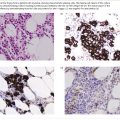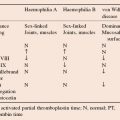Thrombosis
Thrombosis is the pathological process whereby platelets and fibrin interact with the vessel wall to form a haemostatic plug to cause vascular obstruction. It may be arterial, causing ischaemia, or venous, leading to stasis (Fig. 44.1). The thrombus may be subsequently lysed by fibrinolysis, organized, recanalized or embolized. Thrombosis underlies ischaemic heart, cerebrovascular and peripheral vascular diseases, venous occlusion and pulmonary embolism; it plays an important part in pre-eclampsia.
Arterial thrombosis
This occurs in relation to damaged endothelium, e.g. atherosclerotic plaques. Exposed collagen and released tissue factor cause platelet aggregation and fibrin formation (Box 44.1).
Hypertension
Smoking
Diabetes*
Hyperlipidaemia*
↑ Homocysteine*
Polycythaemia/thrombocythaemia
↑ Factor VIII
↑ Fibrinogen
Lupus anticoagulant
Heparin therapy (see Chapter 45)
*May be related to an inherited abnormality
Venous thrombosis
All hospital in-patients are assessed for risk of venous thromboembolism (VTE) and appropriate measures for VTE prophylaxis instituted where indicated. The most common site for deep vein thrombosis (DVT) is the leg which may be below knee or involve veins in the thigh and the iliac veins.
Factors affecting blood flow (e.g. stasis, obesity), alterations in blood constituents and damage to vascular endothelium (e.g. caused by sepsis, surgery or indwelling catheters) are important risk factors (Box 44.2). Diagnosis can be confirmed by imaging, e.g. Doppler ultrasound probe (Fig. 44.1) or, less commonly, venography. Blood tests, e.g. detection of elevated levels of d-dimers, which are derived from fibrinogen, can also be helpful, especially if recurrence is suspected.
Cardiac failure, oedema, nephrotic syndrome
Postoperative
Immobility and bed rest
Trauma
Pelvic obstruction
Stay updated, free articles. Join our Telegram channel

Full access? Get Clinical Tree





